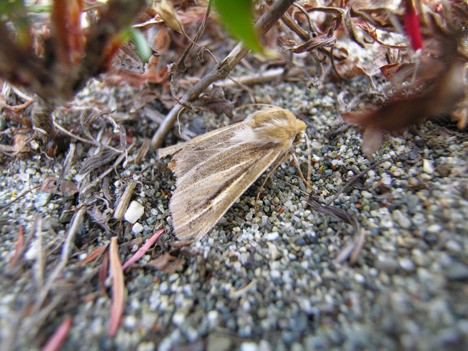A petition has been filed seeking endangered species listing for a rare coastal moth found in four coastal areas of British Columbia and six coastal areas of Washington state, including American Camp on San Juan Island.
WildEarth Guardians and The Xerces Society for Invertebrate Conservation say the sand verbena moth is “on the edge of extinction” because of habitat changes caused by invasive dune grasses, high recreational use of coastal dunes, and rising sea levels and increased storm surges due to climate change.
“The Endangered Species Act can help reign in these threats,” the organizations stated in a press release.
The Xerces Society had no population estimates, but said only 10 populations of the moth are known in coastal areas in Washington and British Columbia. Within its range, the moth depends on dune coastal habitat containing relatively large stands of its host plant, the yellow sand verbena.
Canada listed the moth as endangered under its Species At Risk Act in 2005 and released its recovery strategy in 2008.
“It makes sense for the United States to work with Canada to protect this endangered animal,” said Sarina Jepsen, director of the Xerces Society’s Endangered Species Program. “The first step in that process is to follow Canada’s lead and list this species under the Endangered Species Act.”
Jepsen said endangered species listing could help another imperiled insect on the American Camp prairie: the Island Marble butterfly. The U.S. declined to list the Island Marble, which was believed to be extinct until it was discovered living on American Camp prairie mustards in 1998; the butterfly no longer exists on Gabriola and Vancouver islands.
Island Marble populations are found predominately at American Camp, though strays have been found on Lopez Island and on the site of the new San Juan Community Home Trust neighborhood near the former Friday Harbor Sand and Gravel.
Despite the lack of listing, the National Park Service and the U.S. Fish and Wildlife Service have a plan to manage Island Marble habitat at American Camp (the National Park is in the midst of a 50-year plan to restore the American Camp prairie). And the home trust is working to preserve areas where the Island Marble may flourish on its property.
A habitat management plan for the sand verbena moth could help the Island Marble butterfly. Xerces Society executive director Scott Hoffman Black said one Island Marble population “co-occurs” with the sand verbena moth.
Jepsen said the sand verbena moth is important as a “bellwether” of a fragile ecosystem. The moth is dependent on the rare sand dune plant for which it is named. The adult lays its eggs on the plant, the larvae feed on the plant, and the adult nectars on the yellow flowers of the plant.
If endangered species listing is approved, a critical habitat would be designated and a recovery plan developed.
Meanwhile, Jepsen said there are steps islanders can take now to help the sand verbena moth. Stay on trails. Don’t displace native plants by introducing non-native plants. The European beach grass introduced to prevent sand dune erosion has displaced the sand verbena plant, on which the moth depends. And report sand verbena moth sightings so scientists can track the population.
Island Marble ‘not being found in as many places as it was’
Hoffman Black said reports show the Island Marble butterfly population is having a tough time, despite more public awareness and caution in its presence.
He didn’t have population estimates – in 2006, the population was estimated to be as high as 1,000 — but the butterfly is “not being found in as many places as it was.”
The main population is at American Camp. Populations have been found at sites outside of American Camp, but some of those populations haven’t been found again, he said.
“Recovery is a long-term thing,” Hoffman Black said. “It may have taken 100 years for this butterfly to become endangered. It’s going to take many years for true recovery.”
Hoffman Black said endangered species protections do work. The Karner blue butterfly was listed as threatened and a conservation plan put in place. “Today, its future is looking bright. But it hasn’t recovered yet,” he said.
— Online: The Island Marble butterfly conservation agreement
— Online: Petition to list the sand verbena moth as an endangered species



